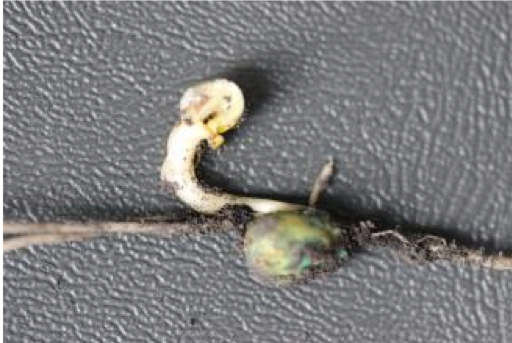Brought to you by: Jonah T. Johnson, MS, CPAg, CCA - Sales Agronomist, PCT | Sunrise
April 2, 2020: What’s your Soil temperature?? don’t plant until conditions are right!
Soil temperature, cold injury and imbibitional chilling
As the saying goes, April showers bring May flowers, but they can also cause unwanted planting delays for corn and soybean production. To bear the fruits of our labor in the fall, we need to give our seed the best chance we can from the day of planting, throughout the entire growing season.
So, like the article “catch-phrase,” asks, “what is your soil temperature?”
Soil temperatures across the state vary, with most residing below 50 degrees Fahrenheit. As of April 1st, 2020.
As the saying goes, April showers bring May flowers, but they can also cause unwanted planting delays for corn and soybean production. To bear the fruits of our labor in the fall, we need to give our seed the best chance we can from the day of planting, throughout the entire growing season.
So, like the article “catch-phrase,” asks, “what is your soil temperature?”
Soil temperatures across the state vary, with most residing below 50 degrees Fahrenheit. As of April 1st, 2020.
| OARDC Weather Station Data | ||
| Soil Temps (Degrees F) | ||
| Depth (in inches) | ||
| Location | 2 | 4 |
| Columbus | 47.87 | 47.7 |
| Wooster | 46.12 | 45.92 |
| South Charleston | 39.3 | 39.47 |
| Custar (NW OH) | 42.83 | 42.49 |
| Piketon | 49.98 | 50.45 |
So why is 50-degree soil temperature and above important?
While we are all anxious to get those planters rolling, jumping the gun and planting into soils that are not up to temperature can have detrimental effects to the crops planted. No greater example of this has been shown than from recent springs when planters rolled 7-10 days early in April and the weather turned cold and wet. This led to poor germination, poor stand and ultimately lower yields or areas that needed to be replanted costing additional time and money. Given we cannot predict the weather, we need to take as many factors into consideration before rolling those planters and soil temperature is a HUGE factor.
To ensure better germination, one of the key factors to consider is optimum soil temperature. Regardless of climate zone, year, soil type or fertility, seed requires an optimum soil temperature to germinate. Planting prior to optimum soil temperature puts your crop at risk for poor germination and limited initial plant growth. There have been numerous studies completed identifying optimum soil temperatures.
The recommended minimum temperatures per the Nebraska-Lincoln Extension are as follows:
| Crop | Minimum Soil Temperature at Planting |
| Spring Wheat | 37°F |
| Alfalfa | 45°F |
| Field Corn | 55°F |
| Soybeans | 59°F |
| Cabbage | 45°F |
| Carrot | 46°F |
| Sweet Corn | 55°F |
| Pepper | 57°F |
| Tomato | 57°F |
| Cucumber | 58°F |
| Pumpkin | 60°F |
Soil temperature is affected by other factors such as:
- Residue:
- The greater the residue the slower the soil is to warm (and dry)
- Prostrate growing winter annual weeds prevent soil warming (and drying)
- Soil Moisture:
- It takes more energy (solar radiation) to warm wet soil as compared to dry soil
- Slope:
- South facing slopes are always warmer than a north facing slopes (in the northern hemisphere)
- Tillage:
- Shallow tillage and creating a “dust mulch” reduces the heat flow between the surface and sub soil
- Cultivated soil has a greater temperature aptitude compared to uncultivated soil
- The air temperature 1 inch above the soil is 9-18°F higher in cultivated soil compared to uncultivated soil mid-day
- Soil Texture:
- Sandy soils warm up more rapidly than clay soils
- Sandy soils have higher temperature over winter
- Organic Matter:
- Organic matter reduces the heat capacity and thermal conductivity of the soil and increases absorptivity due to the dark color
Please consider all factors when making the decision to plant or hold off for a few days. According to the Purdue Extension Corn and Soybean Field guide, a delay in planting from mid-April to early May (15 days) would not impact optimum yield at most populations.
Imbibitional Chilling versus Cold injury
| Imbibitional chilling occurs when there is a drastic change in the water temperature during imbibition. The critical time for this to occur is within 24 hours of planting.  |
| Cold Injury is when there is a change in the soil temperature after the seed has imbibed water.  |
The effects of imbibitional chilling and cold injury are ultimately the same – reduced stand establishment and seedling vigor. Severe imbibitional chilling can result in seed death, ‘corkscrewing’ of the mesocotyl, and leafing out underground as well as surviving seedlings having reduced seedling vigor. Cold injury is typically less severe than imbibitional chilling. Regardless, the impact of a temperature drop is dependent on how big the temperature drop is, how long cold temperatures persist, and what the seed quality was.
